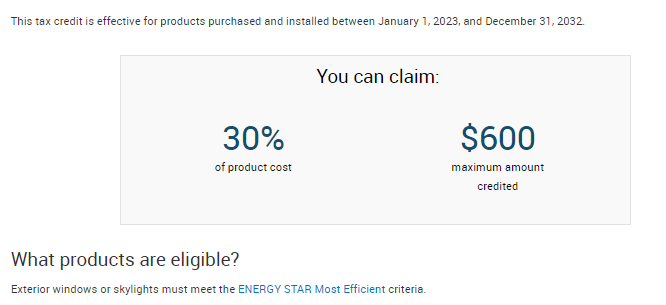Energy Star
Energy Star 7.0 went into effect on 10/23/23 for Residential Windows, Doors, and Skylights. The new criteria certifying a window/ door product as Energy Star 7.0 is a significant jump from the Energy Star 6.0 criteria. This change will be associated with increased manufacturing costs which will ultimately be passed on to the consumer. The cost difference of an Energy Star 7.0 window and door package is paired with the minor annual energy savings for homeowners.
Pulled from Energy Star’s website is the cost savings chart below. We highlighted the cost savings going from similar performance to our current glass package to an Energy Star 7.0 package indicating $67.15 annual energy savings. With an estimated $70 per window upcharge for an Energy Star 7.0 window package, this implies that it would take over 20-years for a homeowner to break even on a 20-unit window package.

Is there an Energy Tax Credit on Energy Star 7.0 products?
Yes, you can claim up to 30% of product cost for a maximum credit of $600. The catch, however, is that this is only eligible on products that fit the “Energy Star Most Efficient” criteria. This means that you can purchase Energy Star 7.0 products and still not receive a tax credit for it. Energy Star Most Efficient products are likely to come at an even higher premium. See the information below pulled from the Energy Star website:

U-Factor to R-Value conversion
An R-Value can be calculated by dividing 1 by the U-Factor. For example, a U-Factor of 0.30 has an R-Value of 3.33. A U-Factor of .25 has a R-Value of 4. This small .67 R-Value is the difference between Energy Star 6 and Energy Star 7.0 in the North Central region. In short, this slight R-Value difference translates to minor annual savings at the cost of a significant upfront premium.
What Manufacturers are doing to Meet Energy Star 7.0 and why it is not Ideal
To meet Energy Star 7.0, manufacturers are adding additional layers of complexity to their glass package. Two ways they are doing so is by going to triple pane window packages and by offering two coats of Low-E glass. Both cases present negative points worth considering. Triple panes cost significantly more than double panes, and the complexity of the glass package has a higher chance of issues occurring in the field. When offering two coats of Low-E manufacturers are coating the 2nd surface (inside the glass unit) and the 4th surface (Interior of the home). The downside to this is the Low-E coating is a thin layer, susceptible to scratching. With it being applied to the interior facing surface, this can easily be damaged when cleaning your windows.
